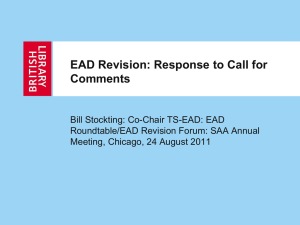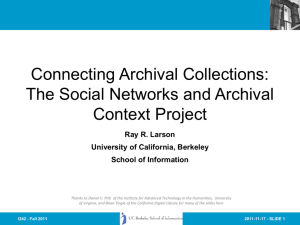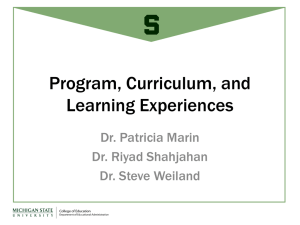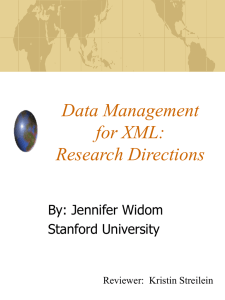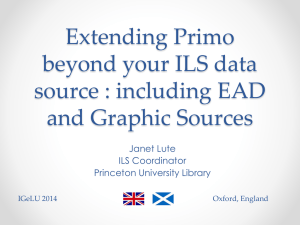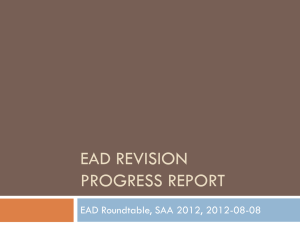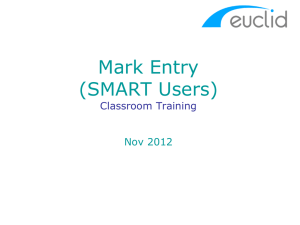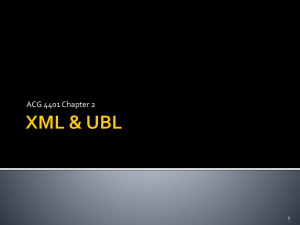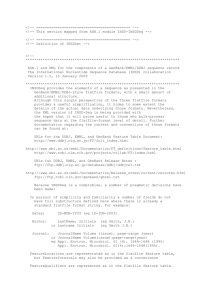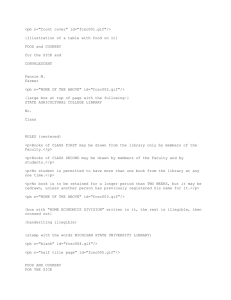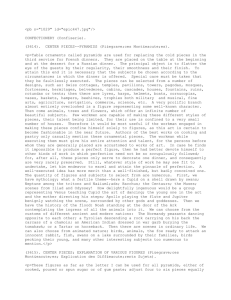- Courses - University of California, Berkeley
advertisement
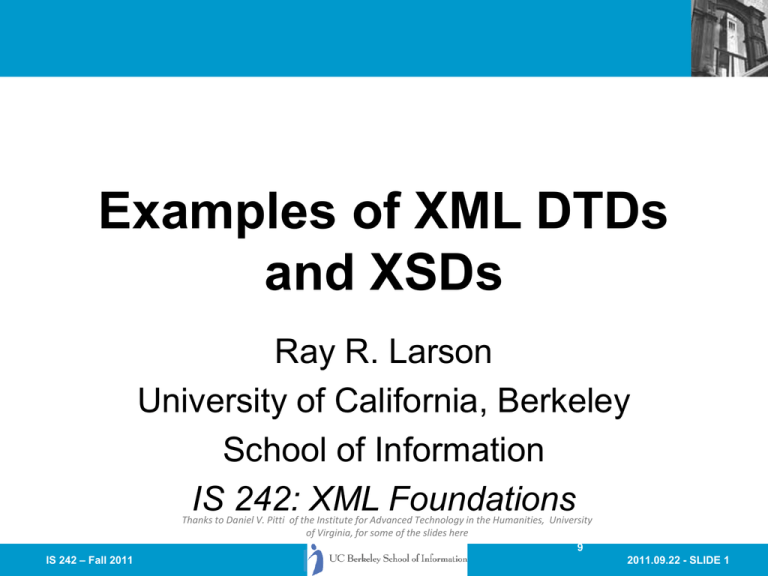
Examples of XML DTDs and XSDs Ray R. Larson University of California, Berkeley School of Information IS 242: XML Foundations Thanks to Daniel V. Pitti of the Institute for Advanced Technology in the Humanities, University of Virginia, for some of the slides here 9 IS 242 – Fall 2011 2011.09.22 - SLIDE 1 XML as a common syntax • XML (and SGML) provide a way of expressing the structure of documents that can be verified and validated by document processing systems • “Documents” can be metadata structures – Such as the description of a particular photograph in your assignments • XML thus provides a way of representing metadata descriptions as well as the content that they describe 9 IS 242 – Fall 2011 2011.09.22 - SLIDE 2 XML as a common syntax • All XML documents follow some simple rules that make them interchangeable and usable across different systems – All data and markup is in UNICODE – All elements are marked by begin and end tags – All markup is case-sensitive – XML DTD’s and/or Schemas define the valid structure (and sometimes content) of the documents 9 IS 242 – Fall 2011 2011.09.22 - SLIDE 3 Dublin Core • Review? • Simple metadata for describing internet resources • For “Document-Like Objects” • 15 Elements 9 IS 242 – Fall 2011 2011.09.22 - SLIDE 4 Dublin Core Elements • • • • • • • • Title Creator Subject Description Publisher Other Contributors Date Resource Type • • • • • • • Format Resource Identifier Source Language Relation Coverage Rights Management 9 IS 242 – Fall 2011 2011.09.22 - SLIDE 5 DC XML DTD Implementation • There have been various versions • This one is the one recommended (required) by the Open Archives Initiative Metadata Harvesting Protocol (OAI-MHP) • Uses XML Name Spaces • Available at http://dublincore.org/documents/2001/09/20/dcmes-xml/ 9 IS 242 – Fall 2011 2011.09.22 - SLIDE 6 DC Element and Attribute Definitions <!-- The elements from DCMES 1.1 --> <!-- The name given to the resource. --> <!ELEMENT dc:title (#PCDATA)> <!ATTLIST dc:title xml:lang CDATA #IMPLIED> <!-- An entity primarily responsible for making the content of the resource. --> <!ELEMENT dc:creator (#PCDATA)> <!ATTLIST dc:creator xml:lang CDATA #IMPLIED> <!-- The topic of the content of the resource. --> <!ELEMENT dc:subject (#PCDATA)> <!ATTLIST dc:subject xml:lang CDATA #IMPLIED> <!-- An account of the content of the resource. --> <!ELEMENT dc:description (#PCDATA)> <!ATTLIST dc:description xml:lang CDATA #IMPLIED> <!-- The entity responsible for making the resource available. --> <!ELEMENT dc:publisher (#PCDATA)> <!ATTLIST dc:publisher xml:lang CDATA #IMPLIED> <!-- An entity responsible for making contributions to the content of the resource. --> <!ELEMENT dc:contributor (#PCDATA)> <!ATTLIST dc:contributor xml:lang CDATA #IMPLIED> <!-- A date associated with an event in the life cycle of the resource. --> <!ELEMENT dc:date (#PCDATA)> <!ATTLIST dc:date xml:lang CDATA #IMPLIED> 9 IS 242 – Fall 2011 2011.09.22 - SLIDE 7 DC Element Definitions (cont.) <!-- The nature or genre of the content of the resource. --> <!ELEMENT dc:type (#PCDATA)> <!ATTLIST dc:type xml:lang CDATA #IMPLIED> <!-- The physical or digital manifestation of the resource. --> <!ELEMENT dc:format (#PCDATA)> <!ATTLIST dc:format xml:lang CDATA #IMPLIED> <!-- An unambiguous reference to the resource within a given context. --> <!ELEMENT dc:identifier (#PCDATA)> <!ATTLIST dc:identifier xml:lang CDATA #IMPLIED> <!ATTLIST dc:identifier rdf:resource CDATA #IMPLIED> <!-- A Reference to a resource from which the present resource is derived. --> <!ELEMENT dc:source (#PCDATA)> <!ATTLIST dc:source xml:lang CDATA #IMPLIED> <!ATTLIST dc:source rdf:resource CDATA #IMPLIED> <!-- A language of the intellectual content of the resource. --> <!ELEMENT dc:language (#PCDATA)> <!ATTLIST dc:language xml:lang CDATA #IMPLIED> <!-- A reference to a related resource. --> <!ELEMENT dc:relation (#PCDATA)> <!ATTLIST dc:relation xml:lang CDATA #IMPLIED> <!ATTLIST dc:relation rdf:resource CDATA #IMPLIED> <!-- The extent or scope of the content of the resource. --> <!ELEMENT dc:coverage (#PCDATA)> <!ATTLIST dc:coverage xml:lang CDATA #IMPLIED> <!-- Information about rights held in and over the resource. --> <!ELEMENT dc:rights (#PCDATA)> <!ATTLIST dc:rights xml:lang CDATA #IMPLIED> 9 IS 242 – Fall 2011 2011.09.22 - SLIDE 8 Dublin Core XSD • Example in Oxygen – Of the schema – And a document using it 9 IS 242 – Fall 2011 2011.09.22 - SLIDE 9 A More Complex SGML DTD <!DOCTYPE USMARC [ <!-- USMARC DTD. UCB-SLIS v.0.08 --> <!-- By Jerome P. McDonough, April 1, 1994 --> <!ELEMENT USMARC - - (Leader, Directry, VarFlds)> <!ATTLIST USMARC Material (BK|AM|CF|MP|MU|VM|SE) "BK" id CDATA #IMPLIED> <!-- Author's Note: the id attribute for the USMARC element is intended to hold a unique record number for each MARC record in the local database. That is to say, it is intended ONLY as an aid in maintaining the local database of MARC records --> <!ELEMENT Leader - O (LRL, RecStat, RecType, BibLevel, UCP, IndCount, SFCount, BaseAddr, EncLevel, DscCatFm, LinkRec, EntryMap)> <!ELEMENT Directry - O (#PCDATA)> <!ELEMENT VarFlds - O (VarCFlds, VarDFlds)> <!-- Component parts of Leader --> <!-- Logical Record Length --> <!ELEMENT LRL - O (#PCDATA)> …etc… 9 IS 242 – Fall 2011 2011.09.22 - SLIDE 10 More Complex DTD (cont.) <!-- Variable Data Fields --> <!ELEMENT VarDFlds - O (NumbCode, MainEnty?, Titles, EdImprnt?, PhysDesc?, Series?, Notes?, SubjAccs?, AddEnty?, LinkEnty?, SAddEnty?, HoldAltG?, Fld9XX?)> <!-- Component Parts of Variable Data Fields --> <!-- Numbers & Codes --> <!ELEMENT NumbCode - O (Fld010?, Fld011?, Fld015?, Fld017*, Fld018?, Fld019*, Fld020*, Fld022*, Fld023*, Fld024*, Fld025*, Fld027*, Fld028*, Fld029*, Fld030*, Fld032*, Fld033*, Fld034*, Fld035*, Fld036?, Fld037*, Fld039*, Fld040?, Fld041?, Fld042?, Fld043?, Fld044?, Fld045?, Fld046?, Fld047?, Fld048*, Fld050*, Fld051*, Fld052*, Fld055*, Fld060*, Fld061*, Fld066?, Fld069*, Fld070*, Fld071*, Fld072*, Fld074*, Fld080?, Fld082*, Fld084*, Fld086*, Fld088*, Fld090*, Fld096*)> <!-- Main Entries --> <!ELEMENT MainEnty - O (Fld100?, Fld110?, Fld111?, Fld130?)> <!-- Titles --> <!ELEMENT Titles - O (Fld210?, Fld211*, Fld212*, Fld214*, Fld222*, Fld240?, Fld242*, Fld243?, Fld245, Fld246*, Fld247*)> <!-- Edition, Imprint, etc. --> <!ELEMENT EdImprnt - O (Fld250?, Fld254?, Fld255*, Fld256?, Fld257?, Fld260?, Fld261?, Fld262?, Fld263?, Fld265?)> <!-- Physical Description, etc. --> <!ELEMENT PhysDesc - O (Fld300*, Fld305*, Fld306?, Fld310?, Fld315?, Fld321*, Fld340*, Fld350?, Fld351*, Fld355*, Fld357*, Fld362*)> …etc… 9 IS 242 – Fall 2011 2011.09.22 - SLIDE 11 Complex DTD (cont.) <!-- Title Statement --> <!ELEMENT Fld245 - O (Six?, (a|b|c|f|g|h|k|n|p|s)+)> <!ATTLIST Fld245 AddEnty (No|Yes|Blank) #IMPLIED NFChars (0|1|2|3|4|5|6|7|8|9|Blnk) #IMPLIED> …etc… <!-- Subfield Element Declarations --> <!ELEMENT a - O (#PCDATA)> <!ELEMENT b - O (#PCDATA)> <!ELEMENT c - O (#PCDATA)> <!ELEMENT d - O (#PCDATA)> <!ELEMENT e )> - O (#PCDATA 9 IS 242 – Fall 2011 2011.09.22 - SLIDE 12 Example – METS • METS – the Metadata Encoding and Transmission Standard is a new Schema intended to provide: – “a standard for encoding descriptive, administrative, and structural metadata regarding objects within a digital library, expressed using the XML schema language of the World Wide Web Consortium” • METS can be used to “wrap” complex sets of data (the actual data, with rules for encoding binary forms), the metadata describing the parts of that data, and the sequence and conditions under which the data can or should be presented or displayed 9 IS 242 – Fall 2011 2011.09.22 - SLIDE 13 Other Protocols and Metadata Systems Using XML • SOAP (Simple Object Access Protocol) • SRW (Search and Retrieval for the Web) • OAI-MHP (Open Archives Initiative Metadata Harvesting Protocol) • RDF (Resource Description Framework) • MPEG-7 (more next time) • METS • ADL Gazetteer Protocol • DAV/DASL (Distributed Authoring and Versioning) • SDLIP (Simple Digital Library Interoperability Protocol) • Also versions of MARC and other formats in XML 9 IS 242 – Fall 2011 2011.09.22 - SLIDE 14 Components of Archival Description • Description of records • Context of creation: creators • Functions and activities documented in records • Dedicated descriptive semantics and structure for each component • Components interrelated with one another 9 IS 242 – Fall 2011 2011.09.22 - SLIDE 15 Records: EAD • Encoded Archival Description – Society of American Archivists and Library of Congress – Used internationally – English, Spanish, Dutch, French, and Chinese • 1998, 2002 • Official site at http://www.loc.gov/ead/ 9 IS 242 – Fall 2011 2011.09.22 - SLIDE 16 What EAD Is • An emerging encoding and structural standard for archival description – Data structure – Communication/interchange – Finding aid / archival description • Based on principles of ISAD(G): General International Standard Archival Description, Second edition 9 IS 242 – Fall 2011 2011.09.22 - SLIDE 17 What EAD Is Not • Content standard • Data value standard • Archival management system 9 IS 242 – Fall 2011 2011.09.22 - SLIDE 18 Principals of Record Description • Respect de fonds – Provenance – Original order • Hierarchical and symmetrical • Inheritance of description 9 IS 242 – Fall 2011 2011.09.22 - SLIDE 19 The EAD DTD • The EAD DTD is very complex and permits considerable flexibility in expressing the description and topics of the archival collection. • The main parts are outlined on the following slides, but include: – A header, including basic descriptive info. – Optional frontmatter – The archival description • We will describe only a few of the top-level tags 9 IS 242 – Fall 2011 2011.09.22 - SLIDE 20 Major Sections and DTD Defs • EAD – <!ELEMENT ead (eadheader, frontmatter?, archdesc) > • EADHeader: – <!ELEMENT eadheader (eadid, filedesc, profiledesc?, revisiondesc?) > – FILEDESC • <!ELEMENT filedesc (titlestmt, editionstmt?, publicationstmt?, seriesstmt?, notestmt?) > 9 IS 242 – Fall 2011 2011.09.22 - SLIDE 21 Major Sections and DTD Defs • The Archival Description: – <!ELEMENT archdesc (runner*, did, (admininfo | bioghist | controlaccess | odd | scopecontent | organization | arrangement | add | dsc | dao | daogrp | note' )*)> • The Descriptive Identification – <!ELEMENT did (head?, (abstract | physdesc | note | repository | origination | unitdate | unitid | unittitle | container | physloc | dao | daogrp)*)> 9 IS 242 – Fall 2011 2011.09.22 - SLIDE 22 Example EAD Record (Hub) <ARCHDESC LEVEL = "FONDS" LANGMATERIAL = "English"> <EAD> <DID> <EADHEADER LANGENCODING = "ISO 639"> <REPOSITORY> <EADID> University of Manchester, John Rylands University Library of Manchester GB 0133 TAB </REPOSITORY> </EADID> <UNITID ENCODINGANALOG = "ISADG3.1.1." COUNTRYCODE = "GB" <FILEDESC> REPOSITORYCODE = "0133"> <TITLESTMT> GB 0133 TAB <TITLEPROPER> </UNITID> Tabley Muniments <UNITTITLE LABEL = "Title" ENCODINGANALOG = "ISADG3.1.2."> </TITLEPROPER> Tabley Muniments </TITLESTMT> </UNITTITLE> <PUBLICATIONSTMT> <UNITDATE LABEL = "Dates of Creation" ENCODINGANALOG = "ISADG3.1.3."> <PUBLISHER> 19th century John Rylands University Library of </UNITDATE> Manchester <PHYSDESC LABEL = "Extent" ENCODINGANALOG = "ISADG3.1.5."> </PUBLISHER> <EXTENT> <ADDRESS> 1.24 cu.m <ADDRESSLINE> </EXTENT> 150 Deansgate </PHYSDESC> </ADDRESSLINE> <ORIGINATION LABEL = "Creator" ENCODINGANALOG = "ISADG3.2.1."> <ADDRESSLINE> <FAMNAME SOURCE = "NCARULES"> Manchester Warren, family, of Tabley, Cheshire </ADDRESSLINE> </FAMNAME> <ADDRESSLINE> <PERSNAME SOURCE = "NCARULES"> ... (Parts removed )… Warren, John Byrne Leicester, 1835-1895, 3rd Baron de Tabley, poet </FRONTMATTER> </PERSNAME> </ORIGINATION> </DID> 9 IS 242 – Fall 2011 2011.09.22 - SLIDE 23 Example EAD Record (Hub) <BIOGHIST ENCODINGANALOG = "ISADG3.2.2."> <HEAD> Administrative/Biographical History </HEAD> <P> The poet John Byrne Leicester Warren, later 3rd and last Baron de Tabley, of Tabley near Knutsford, Cheshire, was born in 1835, the son of the 2nd Baron de Tabley (1811-1887), and his wife, Catherina. His mother was Italian, the daughter of the count de Soglio, and Warren spent much of his early childhood with her in Italy and Greece. He was educated at Eton and Christ Church, Oxford. At Oxford he published a volume of poetry. Originally he published under the pseudonyms George F. Preston (1859-1862) and William Lancaster (1863-1868), but latterly under his own name. </P> <P> His early verse included <TITLE> Praeterita </TITLE> (1863), <TITLE> Eclogues and Monodramas </TITLE> (1864), <TITLE> Studies in Verse </TITLE> (1865), <TITLE> Philocletes </TITLE> (1866), and <TITLE> Orestes </TITLE> (1868). His early work was Tennysonian in style, but he was later to be influenced by both Browning and Swinburne. In 1873 he produced …. (some data removed)… 9 IS 242 – Fall 2011 2011.09.22 - SLIDE 24 Example EAD Record (Hub) <SCOPECONTENT ENCODINGANALOG = "ISADG3.3.1."> <HEAD> Scope and Content </HEAD> <P> The collection consists mainly of the personal papers of the 3rd Baron de Tabley. The papers reflect his interests in literature, politics, botany and numismatics and include correspondence with numerous prominent later Victorian figures. Attention should also be drawn to de Tabley’s extensive and important collection of armorial bookplates. </P> <P> Correspondents include Sir Mountstuart Grant Duff, Edmund Gosse, Lord Houghton, A.C.Benson, and Robert Bridges. There are volumes of Tabley's essays and verse, as well as a considerable number of notebooks and loose manuscripts of verse and other writings. There are various bundles and boxes relating to &quot;Coins&quot;, &quot;Botany&quot;, &quot;Poetry&quot;, &quot;Literary&quot;, &quot;Financial&quot; and bookplates. </P> </SCOPECONTENT> <ADD> <OTHERFINDAID ENCODINGANALOG = "ISADG3.4.6."> <P> Preliminary survey list. </P> </OTHERFINDAID> <RELATEDMATERIAL ENCODINGANALOG = "ISADG3.5.3."> <P> There is correspondence with the 3rd Baron de Tabley among the Edward Freeman Papers, held at JRULM. The Library also has custody of the important Tabley Book Collection. </P> </RELATEDMATERIAL> <SEPARATEDMATERIAL> <P> The family and estate papers of the Leicester-Warren Family of Tabley are held by Cheshire Record Office. Some of these papers were originally in the custody of the John Rylands University Library of Manchester. </P> </SEPARATEDMATERIAL> </ADD> 9 IS 242 – Fall 2011 2011.09.22 - SLIDE 25 Example EAD Record (Hub) <CONTROLACCESS> <HEAD> Index terms </HEAD> <GEOGNAME SOURCE = "NCARULES"> <EMPH ALTRENDER = "a">Tabley Inferior</EMPH> <EMPH ALTRENDER = "a-">Cheshire SJ7378</EMPH> </GEOGNAME> <PERSNAME SOURCE = "NCARULES"> <EMPH ALTRENDER = "surname">Benson</EMPH> <EMPH ALTRENDER = "forename">Arthur Christopher</EMPH> <EMPH ALTRENDER = "dates">1862-1923</EMPH> </PERSNAME> <PERSNAME SOURCE = "NCARULES"> <EMPH ALTRENDER = "surname">Bridges</EMPH> <EMPH ALTRENDER = "forename">Robert Seymour</EMPH> <EMPH ALTRENDER = "dates">1844-1930</EMPH> </PERSNAME> <PERSNAME SOURCE = "NCARULES"> <EMPH ALTRENDER = "surname">Duff</EMPH> <EMPH ALTRENDER = "title">Sir</EMPH> <EMPH ALTRENDER = "forename">Mountstuart Elphinstone Grant</EMPH> <EMPH ALTRENDER = "dates">1829-1906</EMPH> <EMPH ALTRENDER = "epithet">Knight</EMPH> </PERSNAME> <PERSNAME SOURCE = "NCARULES"> <EMPH ALTRENDER = "surname">Gosse</EMPH> <EMPH ALTRENDER = "title">Sir</EMPH> <EMPH ALTRENDER = "forename">Edmund William</EMPH> <EMPH ALTRENDER = "dates">1849-1928</EMPH> <EMPH ALTRENDER = "epithet">Knight</EMPH> </PERSNAME> <PERSNAME SOURCE = "NCARULES"> <EMPH ALTRENDER = "surname">Milnes</EMPH> <EMPH ALTRENDER = "forename">Richard Monckton</EMPH> <EMPH ALTRENDER = "dates">1809-1885</EMPH> <EMPH ALTRENDER = "epithet">1st Baron Houghton</EMPH> </PERSNAME> <SUBJECT SOURCE = "LCSH"> <EMPH ALTRENDER = "a">Bookplates</EMPH> </SUBJECT> <SUBJECT SOURCE = "LCSH"> <EMPH ALTRENDER = "a">Botany</EMPH> </SUBJECT> <SUBJECT SOURCE = "LCSH"> <EMPH ALTRENDER = "a">Numismatics</EMPH> </SUBJECT> <SUBJECT SOURCE = "LCSH"> <EMPH ALTRENDER = "a-">Poetry</EMPH> <EMPH ALTRENDER = "a">Modern</EMPH> <EMPH ALTRENDER = "y">19th century</EMPH> </SUBJECT> </CONTROLACCESS> </ARCHDESC> </EAD> 9 IS 242 – Fall 2011 2011.09.22 - SLIDE 26 EAC-CPF • EAD is now complemented by “EAC” or the “Encoded Archival Context” • It is another XML-based standard for descriptions of record creators: corporate bodies, persons and families (CPF) • It was developed as part of an international effort with hopes of being able to link and share information among archives having materials related to particular corporate bodies, persons and families 9 IS 242 – Fall 2011 2011.09.22 - SLIDE 27 Archival Records • Records are the by-products of people living and working as individuals, in organized groups, in families • Records document people living and working • People exist in social-professional contexts, in relation to others • Records document these relations • All records created by the same entity are described together (a fonds or collection) – Creators documented in detail – Many of the people documented in the record referenced in description • Archival descriptions document interrelations among people and records (documents) Daniel V. Pitti § Institute for Advanced Technology in the Humanities § University of Virginia 9 IS 242 – Fall 2011 2011.09.22 - SLIDE 28 EAD Elements Source: J. Robert Oppenheimer Papers (LoC) <origination> <persname source="lcnaf">Oppenheimer, J. Robert, 1904-1967</persname> </origination> <controlaccess> <persname source="lcnaf" encodinganalog="100" role="creator">Oppenheimer, J. Robert, 1904-1967</persname> <persname source="lcnaf" encodinganalog="600" role="subject">Bethe, Hans Albrecht, 1906- --Correspondence</persname> <!-- […] --> <persname source="lcnaf" encodinganalog="600" role="subject">Born, Max, 1882-1970 --Correspondence</persname> <persname source="lcnaf" encodinganalog="600" role="subject">Boyd, Julian P. (Julian Parks), 1903- --Correspondence</persname> <persname source="lcnaf" encodinganalog="600" role="subject">Bush, Vannevar, 1890-1974 --Correspondence</persname> <persname source="lcnaf" encodinganalog="600" role="subject">Casals, Pablo, 1876-1973 --Correspondence</persname> <!-- […] --> <corpname source="lcnaf" encodinganalog="610" role="subject">Institute for Advanced Study (Princeton, N.J.)</corpname> <corpname source="lcnaf" encodinganalog="610" role="subject">Los Alamos Scientific Laboratory</corpname> <!-- […] --> </controlaccess> Daniel V. Pitti § Institute for Advanced Technology in the Humanities § University of Virginia 9 IS 242 – Fall 2011 2011.09.22 - SLIDE 29 EAD Elements Source: Leonard Bernstein Collection (LoC) <c02> <did> <container type="box">1</container> <unittitle>Aaltonen, Erkki <unitdate era="ce" calendar="gregorian">1981</unitdate> </unittitle> <physdesc> <extent>1</extent> </physdesc> </did> </c02> <c02> <did> <unittitle>Abbado, Claudio <unitdate era="ce" calendar="gregorian">1963-90</unitdate> </unittitle> <physdesc> <extent>5</extent> </physdesc> </did> </c02> […] Daniel V. Pitti § Institute for Advanced Technology in the Humanities § University of Virginia 9 IS 242 – Fall 2011 2011.09.22 - SLIDE 30 EAD Elements <bioghist> <head>Biographical Sketch</head> <p>José Marcos Mugarrieta, prior to his term as Mexican consul in San Francisco 18571863, served in the Mexican army from 1837. He saw action in numerous battles and campaigns – Jamaica, under General Canalizo in 1841; Campeche, 1842-1843; Merida, 1843; Veracruz, 1845; Mexico City, 1846; Angostura and Cerro-gordo, 1847; Guanajuato, 1848, and Sierra-Gorda under Bustamante, 1848-1849; and Matamoros, 1849-1850. […] </p> <p>In April 1857 Mugarrieta received an appointment from the Comonfort government for the consulship in San Francisco. He did not actually begin his new duties until September 1, 1859, due to illness and to the political situation in Mexico. […]</p> </bioghist> Daniel V. Pitti § Institute for Advanced Technology in the Humanities § University of Virginia 9 IS 242 – Fall 2011 2011.09.22 - SLIDE 31 EAD Elements <bioghist> <head>Chronology</head> <chronlist> <chronitem> <date>1900</date> <event>Born on Jan. 20 in Hastings, Minnesota.</event> </chronitem> <chronitem> <date>1922</date> <event>Received baccalaureate from Princeton University, major in philosophy. </event> </chronitem> […] <chronitem> <date>1965</date> <event>Died on April 4.</event> </chronitem> </chronlist> </bioghist> Daniel V. Pitti § Institute for Advanced Technology in the Humanities § University of Virginia 9 IS 242 – Fall 2011 2011.09.22 - SLIDE 32 EAC-CPF • Encoded Archival Context-Corporate bodies, Persons, Families • An international communication standard for archival authority control • Based on International Council for Archives, International Standard Archival Authority RecordsCorporate bodies, persons, families (ISAAR(CPF)) • SAA Standards Committee, Technical Subcommittee on Encoded Archival Context • Co-chairs – Katherine Wisser, Simmons College – Anila Angjeli, Bibliothèque nationale de France Daniel V. Pitti § Institute for Advanced Technology in the Humanities § University of Virginia 9 IS 242 – Fall 2011 2011.09.22 - SLIDE 33 Library and Archive Authority Control • Library (or bibliographic) authority control is almost exclusively about the control of names • Archival authority control involves biographicalhistorical description of the CPF entity – Descriptions based on controlled vocabularies, for example, occupations, place of birth and death – But also biographical-historical description • Prose • Chronological list • Archival authority control provides context for understanding records, the context of their creation, the provenance 9 IS 242 – Fall 2011 2011.09.22 - SLIDE 34 VIAF data <identity> <entityType>person</entityType> <nameEntry scriptCode="Latn" xml:lang="eng"> <part>Oppenheimer, J. Robert, 1904-1967.</part> <authorizedForm>AACR2</authorizedForm> </nameEntry> <nameEntry localType="VIAF:MainHeading"> <part>Oppenheimer, J. Robert (Julius Robert), 1904-1967</part> <alternativeForm>VIAF</alternativeForm> </nameEntry> <nameEntry localType="VIAF:MainHeading"> <part>Oppenheimer, Julius Robert, 1904-1967</part> <alternativeForm>VIAF</alternativeForm> </nameEntry> <nameEntry localType="VIAF:x400"> <part>Oppenheimer, Robert</part> <alternativeForm>VIAF</alternativeForm> </nameEntry> <nameEntry localType="VIAF:x400"> <part>Ou-pẽn-hai-mo, 1904-1967</part> <alternativeForm>VIAF</alternativeForm> </nameEntry> </identity> Daniel V. Pitti § Institute for Advanced Technology in the Humanities § University of Virginia 9 IS 242 – Fall 2011 2011.09.22 - SLIDE 35 <existDates> <dateRange> <fromDate standardDate=“1904-04-22”>1904, Apr. 22</fromDate> <toDate standardDate=“1967-02-18”>1967, Feb. 18</toDate> </dateRange> </existDates> <!-- ... --> <localDescription localType="subject"> <term>Science--Societies, etc.</term> </localDescription> <localDescription localType="VIAF:nationality"> <placeEntry countryCode="US"/> </localDescription> <localDescription localType="VIAF:gender"> <term>Male</term> </localDescription> <languageUsed> <language languageCode="eng"/> </languageUsed> <occupation> <term>Physicists.</term> </occupation> <!-- ... --> Daniel V. Pitti § Institute for Advanced Technology in the Humanities § University of Virginia 9 IS 242 – Fall 2011 2011.09.22 - SLIDE 36 <chronList> <chronItem> <date>1904, Apr. 22</date> <placeEntry>New York, N.Y.</placeEntry> <event>Born, New York, N.Y.</event> </chronItem> <!-- ... --> <chronItem> <date>1943-1945</date> <placeEntry>Los Alamos, N. Mex.</placeEntry> <event>Director, Los Alamos Scientific Laboratory, Los Alamos, N. Mex.</event> </chronItem> <!-- ... --> <chronItem> <date>1954</date> <event>(1) Denied security clearance […] (2) Published Science and the Common Understanding […] </event> </chronItem> <!-- ... --> <chronItem> <date>1967, Feb. 18</date> <placeEntry>Princeton, N.J.</placeEntry> <event>Died, Princeton, N.J.</event> </chronItem> </chronList> Daniel V. Pitti § Institute for Advanced Technology in the Humanities § University of Virginia 9 IS 242 – Fall 2011 2011.09.22 - SLIDE 37 <cpfRelation xmlns:xlink="http://www.w3.org/1999/xlink" xlink:type="simple" xlink:role="http://RDVocab.info/uri/schema/FRBRentitiesRDA/Person" xlink:arcrole="correspondedWith"> <relationEntry>Bush, Vannevar, 1890-1974.</relationEntry> <descriptiveNote> <p>recordId: DLC.ms998007.r007</p> </descriptiveNote> </cpfRelation> Daniel V. Pitti § Institute for Advanced Technology in the Humanities § University of Virginia 9 IS 242 – Fall 2011 2011.09.22 - SLIDE 38 <resourceRelation xmlns:xlink="http://www.w3.org/1999/xlink" xlink:arcrole="creatorOf" xlink:role="archivalRecords” xlink:type="simple” xlink:href="http://hdl.loc.gov/loc.mss/eadmss.ms998007"> <relationEntry>J. Robert Oppenheimer Papers, 1799-1980 (bulk 1947-1967)</relationEntry> <objectXMLWrap> <did xmlns="urn:isbn:1-931666-22-9” > <unittitle>Papers <unitdate normal="1799/1980” era="ce” calendar="gregorian">17991980 </unitdate><unitdate label="Bulk Dates" type="bulk" normal="1947/1967” era="ce” calendar="gregorian">(bulk 1947-1967)</unitdate></unittitle> <unitid countrycode="US" repositorycode="US-DLC">MSS35188</unitid> <origination label="Creator"> <persname>Oppenheimer, J. Robert, 1904-1967</persname> </origination> <!-- ... --> <repository><corpname>Manuscript Division. Library of Congress</corpname> </repository> <abstract>Physicist and director of the Institute for Advanced Study, Princeton, New Jersey. [...] Topics include theoretical physics, development of the atomic bomb, the relationship between government and science, nuclear energy, security, and national loyalty. </abstract> </did> </objectXMLWrap> </resourceRelation> Daniel V. Pitti § Institute for Advanced Technology in the Humanities § University of Virginia 9 IS 242 – Fall 2011 2011.09.22 - SLIDE 39 Authority Control • Identifying creator entities and referenced entities (correspondents, etc.) • Recording name or names used by and for them • Rule-based heading or entry formation and control 9 IS 242 – Fall 2011 2011.09.22 - SLIDE 40
